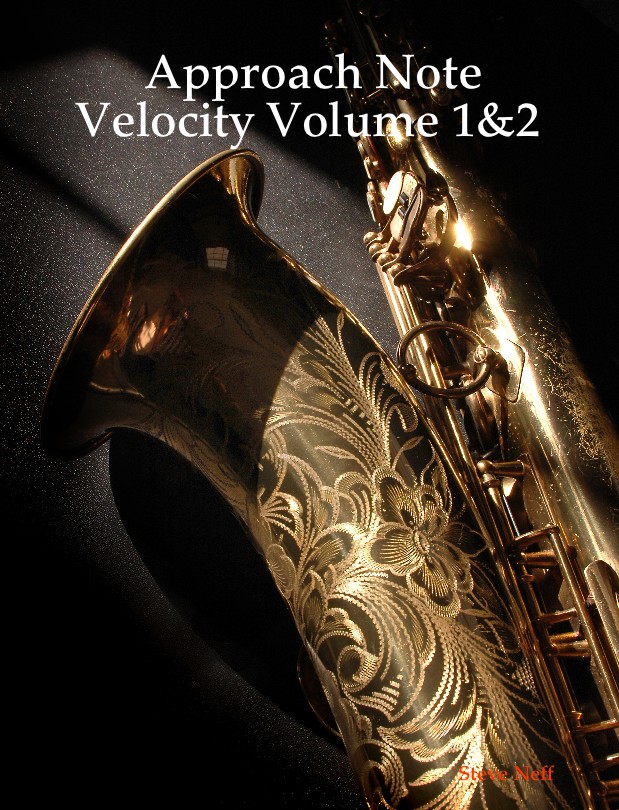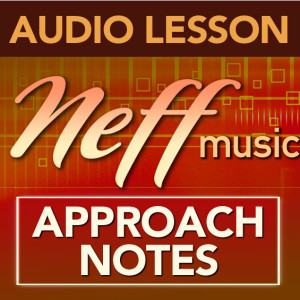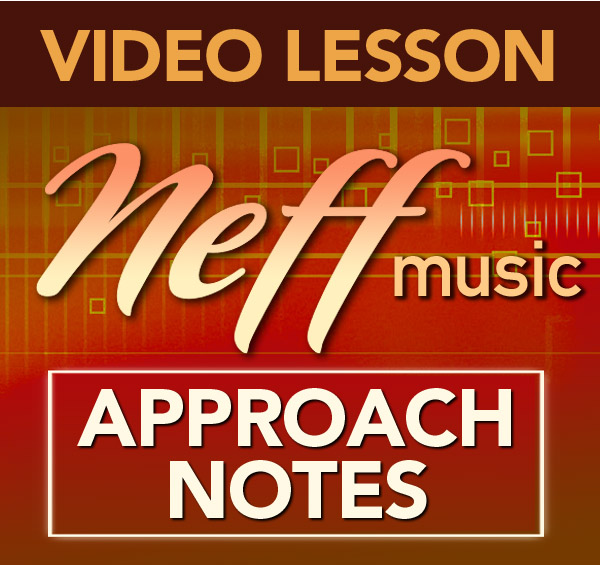Description
A number of years ago, I was frustrated with my playing over static major and minor grooves. It seemed like I always ran out of ideas and the ideas I had were stale and unoriginal. At that time, although I could play in all keys, more often than not I was held back to the same old diatonic patterns and licks I had studied as a kid. Besides this frustration, I felt like there were many keys with which I wasn’t comfortable. As a solution, I decided to come up with a comprehensive method using approach notes that I could use to systematically solve these perceived weaknesses in my playing.
I started by writing out every approach I could think of in every key. For about 4-5 months, I worked on these approaches while playing along to Jamey Aebersold’s Volume 24 “Major and Minor” CD. As I worked on, and added to, my collection of approaches, I saw the positive results in my performances. Not only was I able to play faster over tunes, but I was feeling a confidence that I could start an idea on any note and find a way to resolve it and make it sound good.
As I worked on them in depth, I began to notice that my confidence in every key was improving. Also, the method I was using was helping my ear to more easily hear key centers, and something cool was happening to my time concept. I was starting to play ideas in odd meters against 4. I wasn’t tied down to the 1,2,3,4 groove, but was playing across the bar lines. I really believe that working on these exercises has helped my playing immensely. I hope that you get as much out of these exercises as I have and that they will improve your performances. Thanks, Steve







Paul (verified owner) –
I just ordered and received Steve’s new book a couple of days ago; I had the time to play 3 keys out of the “Approach Note Velocity” book today and I’m delighted! This book’s fun! Steve took the time to do what I’ve been meaning to do for quite a while, (Hat’s off to ya man, I’m too lazy!). He did a great job with this book. The problem of making a line over static harmony interesting is one we saxophonists all encounter, so this book is truly useful. The constant suspension and resolution of the approach note exercises swings like crazy! I’ve been looking for a jazz book with an interesting concept that’s fun to read for quite a while and this one’s a keeper; thanks man
Michele Holevar (verified owner) –
Steve, I am a trauma surgeon with very limited time who is learning to play jazz guitar. I have purchased all of your books ( The Best II-V-I Patterns, Approach Note Velocity or Mastering the Dominant Bebop Scale) and have found them invaluable in giving me an insight into modern improvising. The Mastering the Dominant Bebop Scale is much clearer and user-friendly than the Baker books thtat I had been using (How to Pay Bebop). Instead of just a single riff, you provide building blocks that allow the student to really internalize the Bebop scales and actually make music with them. I am also using Approach Note Velocity in combination with the New York Guitar Method to master the use of chromatics in my playing. I have taken your advice and worked with the Aebersold Major & Minor CDs, and I beieve that the time I have invested in your method has paid off ten-fold. Like you, I have noticed that I am now “playing over the barline” and intuitively using polyrhythms in my playing. Thank you so much for taking the time to develop these books, and please let me know when you develop a new product!
Michele Holevar
Phineas (verified owner) –
I just wanted to let you know that your velocity series was just what I needed. This kind of thing seems to be what was missing in my playing. Not that I would use these patterns all of the time, but they sure do make a cool addition to what I already do. I have read many books “Velocity Patterns”, “Jazz Rock Progressions” By David Chesky, the Bob Mintzer books, Sam Most etc…. These book are cool, however they really do not “break it down” and put the excercises into the hands of the player like your excercises do.
Your Velocity lesson exposed a deficiency in my finger flow. I can zip through many scales, arpeggios, intervals, etc… However, I could not zip through these excercises right away. My fingers just would not co-operate! Especially on flute(my main horn). Just after a few weeks, I have seen a significant improvement across the board. I did a jam session last weekend, and could already feel and hear an improvement when playing on dreaded tunes like Blue Bossa and Footprints. The keyboard player had to signal me to stop because I had so many new ideas…lol It went over like a smash!!!(Good)
These patterns are just fun to play! Just for kicks, I was playing the minor patterns over “Little Sun Flower” and “Sky Dive”. I got a real kick out of that. I am hooked.
Peace, love, and prosperity my sax brother! Thanks again for your time and effort, and look forward to more of your lessons.
Phineas
Claudio Marcolino (verified owner) –
Very good material. Fresh ideas for licks dealing with approach notes. Several licks in all keys. Highly recommended. I bought the printed version from Lulu and packaging was great too. Nicely done, Steve!
Claudio Marcolino (Brazil)
Thomas Korner (verified owner) –
I must tell you that your approach note exercises are such a gift! They were the missing link of my improvisations. I am studying now all types of approaching each chord note of each chord according to your book. It sounds modern and cool, and it helps you to figure out the chord notes as well. Thank you for this book!
Thomas
Tom Schneider (verified owner) –
I have been using Steve’s II-V-I patterns, Approach Note Velocity, and
Mastering the Dominant Bebop Scale books and can honestly say that my
playing has grown more than any other methods I have studied. Steve’s
practical approach really allows someone at any level to apply directly
to their improvising. As a working musician I really do appreciate
methods such as Steve’s that make the best use of my practice time…..
these really work!
Tom Schneider – R&B/Funk/Jazz saxophone during the night, Electrical
Engineer during the day.
John Pritchett (verified owner) –
Steve,
I got the book.
By the way, a few months ago, I noticed a sudden, distinct improvement in the improvising of our lead tenor player. (Joe Sullivan–Blue Moon Big Band.) When I commented on it, he pulled out a copy of Approach Note Velocity. Maybe this book + some hard work will do the same magic for me.
Thanks,
John Pritchett
Randall S. Closson (verified owner) –
I have been working regularly with both Steve’s II-V-I patterns (major and minor) and his Approach Note Velocity books. Instead of going from front to back on these, I concentrated on the keys that I use the most and gradually started delving in to the other keys. After ove 40 years of playing, I have never worked through anything that has opened me up to new ideas and gotten me out of a playing “rut” faster than these books. I am hearing new things in my playing and so are others and I am constantly getting more comfortable playing in any key. I am by no means finished working with these books and consider them a “lifetime” project. Who says you can’t teach an “old dog” new tricks? I just wish I had access to something like this about 35 years ago. Steve can expect that I will be adding his Mastering the Dominant Bebop Scale book to my arsenal very soon.
Randall S. Closson
Ian (verified owner) –
Thank you Steve!
The exercises look good! Just taking a few minutes to flip through the book I can see how well it was made. I also plan to encourage my more advanced students to buy the book.
I’m looking forward to getting my hard copy in the mail from Lulu so I don’t burn up my printer cartridges!
Thanks again, Ian
Sinkdrain (verified owner) –
Well, in searching for a new way to help my students double time during solos I decided to give Steve Neff’s “Approach Note Velocity” book a go.
The youtube clips of his approach reminded me of the lines I often play in the few keys I am very comfortable in. Got the book and realized that I would benefit greatly by working on this myself. Right off the bat it got me playing some appraches and lines I wouldn’t normally reach for. And best of all it got me playing in all the keys. I discovered that the sole reason I was comfortable in certain keys is because I already had a vocabulary of approaches. The book leveled the playing field in my uncomfortable keys by providing new vocabulary.
Another killer thing that I have been doing is taking his smaller approach cells and rhythmically displacing them. To aebersold, I’ll take Neff’s 1st approach and improvise playing all of them on one, then another round on the and of 1, then another round of 2, then beginning the and of 2, etc… This is opening up my awareness of where I am in the bar. Forcing resolutions in locations I never would have otherwise. Cool stuff…
These approaches are also polishing my altissimo register as the cells are very easy to hear and make a nice platform to play them up in that register with a quality tone and intonation.
Get this book… It’s great stuff.
David Machin (verified owner) –
This is a really special kind of teaching material Steve is producing. And it is all laid out easily and without complex terminology. What Steve is really good at doing is showing that starting with very simple ingredients you can make some great lines and that more complex and interesting ideas can easily then be built on these. With Steve’s books I really feel a clear sense of direction and confidence that I am building a repertoire. I can see where I am going and how I can get better. With older kinds of material I often lost my way with it, or just took some bits and pieces here and there, the whole seeming too much. Here if you just get one of Steve’s examples from the book down you can play something that sounds like music. Then you get two down and try combinations. Then you can imagine what will happen when you get say ten down and with more speed. You can see where this will take you. And for me that is the biggest difference with this material: I can see where the work and effort will take me.
Al Elias –
Hi Steve,
I started working on the Approach Note Velocity books I recently purchased. What can I say but Wow! I can’t begin to describe the immediate sense of freedom, confidence and creativity these exercises have brought to my playing! I’m just following your advice (at the beginning of the book) and suddenly, this world of possibility has opened up. improving my ability to improvise…no end! I have a ton of jazz study material but this is by far the most logical approach to improvisation I have studied so far. Thanks so much 🙂
Al Elias